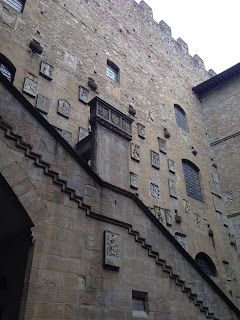Before arriving at our writing residency program in Borseda, Rensing Center’s Ligurian outpost, we spent four days in Florence. What would you do if you were returning to Florence for the sixth time and had seen all the major sites and some minor ones several times? Of course, you would go to the places that you had missed seeing and return to the places that you loved the most.
So, we visited spots that we had never seen but had heard about, like the Museo Davanzati, a museum that offers an excellent example of what a palatial home was like in the 15th century. We revisited the restored Orsanmichele, a church which has always been my personal favorite, but had been closed for many years while it underwent substantial restoration. The statuary on the outside of the church is reason enough to visit. Famous sculptors of the 14th and 15th century executed 14 masterpieces. Each statue was commissioned by a different Florentine guild. But for me the most arresting piece of all is the marble tabernacle constructed by Andrea Orcagna between 1349 and 1359 that houses “la Vergine col Bambino con Angeli” (“the Virgin and the Christ Child with Angels”), painted by Bernardo Daddi. This is a painting that no one should miss seeing.
Orsanmichele just feels like a holy place, although amazingly enough, at one time it was a grain warehouse, which also helps to explain the unusual layout of the church. Lucky for us, our visit to Florence included a Monday morning when the Museo del Orsanmichele is open and offers free admission. Many of the original statues that used to be displayed externally are now housed internally in the museum on the top floor of the old granary. Up here the museum windows afford the visitor an amazing 360-degree panorama of Florence.
We went to Ognissanti, a church on the north side of the Arno, a bit away from everything else, that offers a Ghirlandaio and Botticelli, and we revisited the renovated Santa Maria Novella, which has returned the famous crucifix by Cimabue to its original place and has opened more of the entire monastic complex including the cloister with numerous tombstones.
We stopped by the so-called “Casa di Dante,” a must see for all Dante groupies. We also saw Santo Spirito, as we had somehow missed this capolavoro of Brunelleschi before. It is well worth a trip, especially if you have just been to the nearby Santa Maria della Carmine, which is famous for its fresco cycle in the Cappella Brancacci, painted by Masaccio and Masolino and completed by Filippino Lippi. The expulsion of Adam and Eve from the Garden of Eden is reason enough to visit.
We revisited another personal favorite, the Bargello. There is just way too much to see at the Bargello, even after numerous visits. Last time we were there in 2014, there was an excellent exhibit of Bartolommeo Bandinelli’s sculptures. Bandinelli had been unknown to us before that visit, but now we see his work in other museums and he has become a favorite Renaissance painter and sculptor. It is downright impossible to pick a personal favorite piece of sculpture at the Bargello. Should it be Donatello’s David, Giambologna’s Flying Mercury, or Michelangelo’s Bacchus? Don’t ask me to decide.
The museum where we spent the most time was, fittingly enough, the Uffizi, where we spent over five hours. This included a quick lunch at the outdoor café, which has a tremendous view of the Piazza della Signoria and Santa Maria del Fiore. We still didn’t see everything that the Uffizi offers, but we felt like we had seen a lot and were lucky to have purchased a Firenze Card and were able to avoid the interminable line that snaked around the Uffizi courtyard.
Then we were off to the Piazzale Michelangelo for the view and San Michele al Monte for magical beauty. That’s right, San Minato in the Mountain. The church is on a mountain overlooking Florence from the south east. It is one of two remaining examples of Romanesque architecture in Florence and it, too, just feels like a holy place.
Our personal hit parade also included seeing the inside and outside of the octagonal baptistry in front of the Duomo aka San Giovanni. The baptistry offers an inner dome laden with golden mosaics and external doors that are jaw droppingly beautiful. It is dedicated to John the Baptist, the city’s patron saint. This is where Dante was baptized. I have been captivated by his description of “my beautiful San Giovanni” in Canto XIX of the Inferno, from the moment that I read his description I could feel his love for this sacred place. In this canto Dante describes seeing a child drowning in one of the fonts and how he broke an edge of the font in his attempt to save the child. A thoughtful justification of what could have been a crime and provides a telling explanation of his actions and love for his native city.
-Marjorie Eisenach







No comments:
Post a Comment